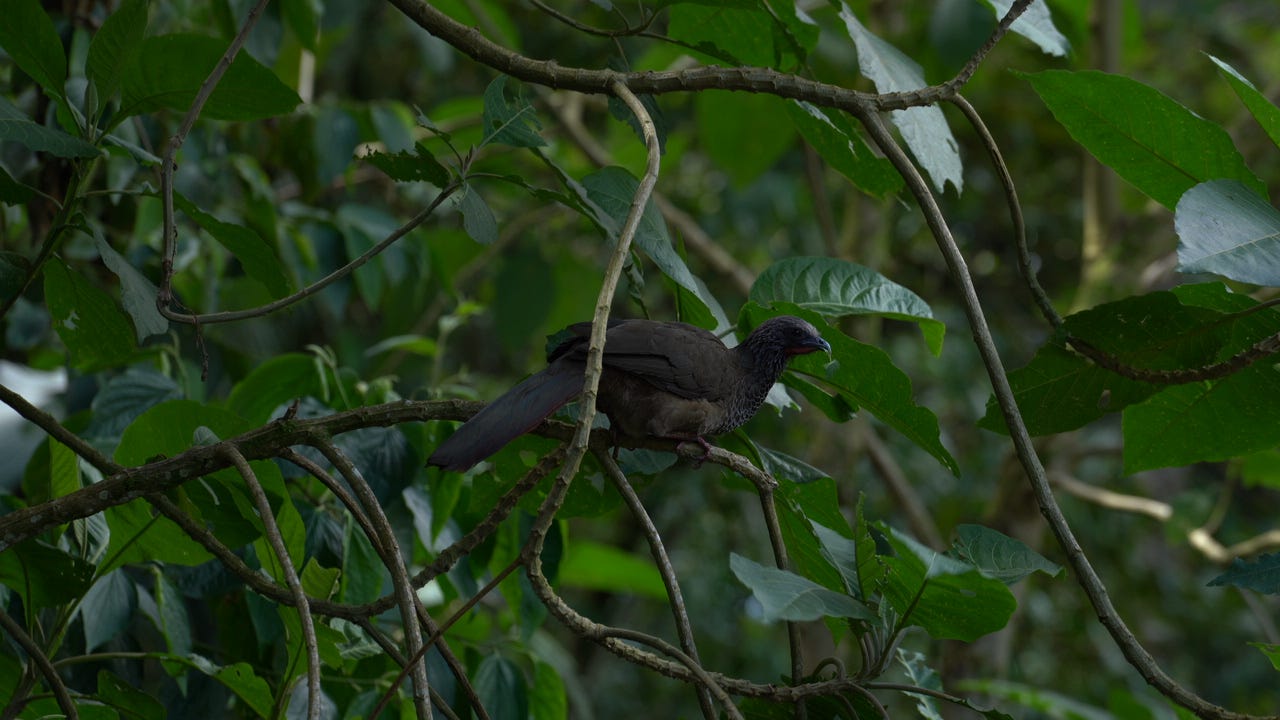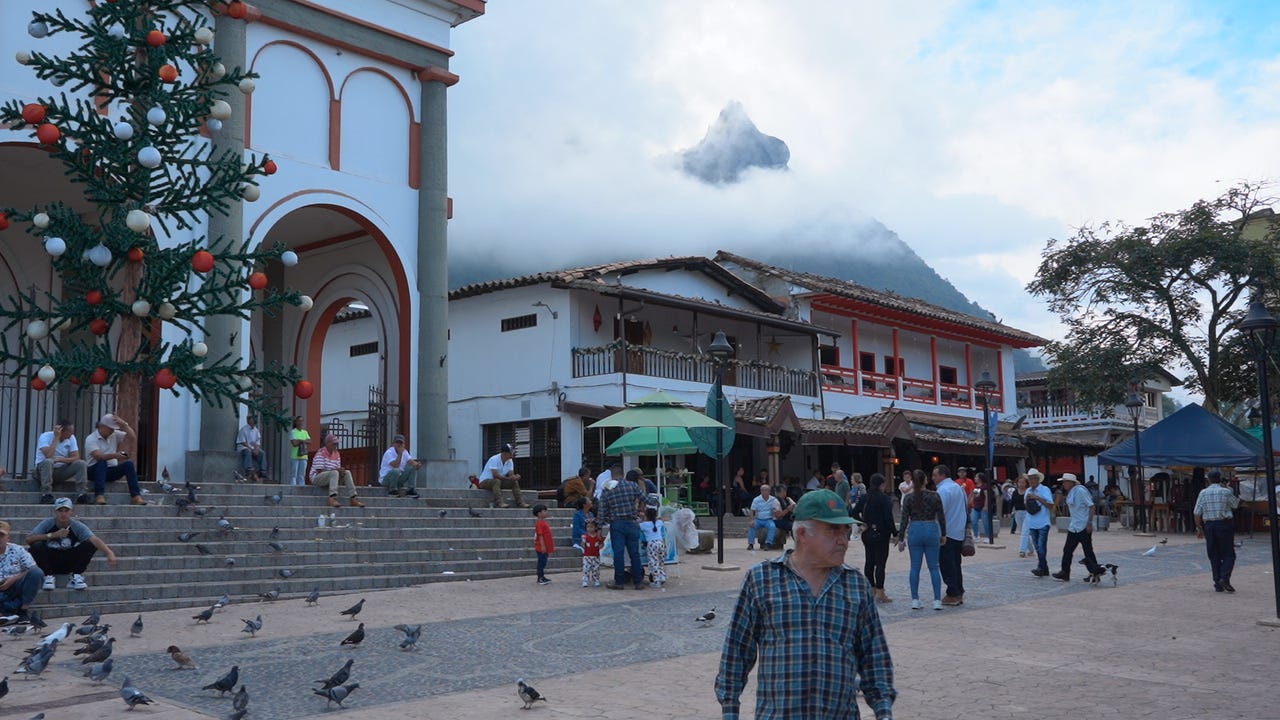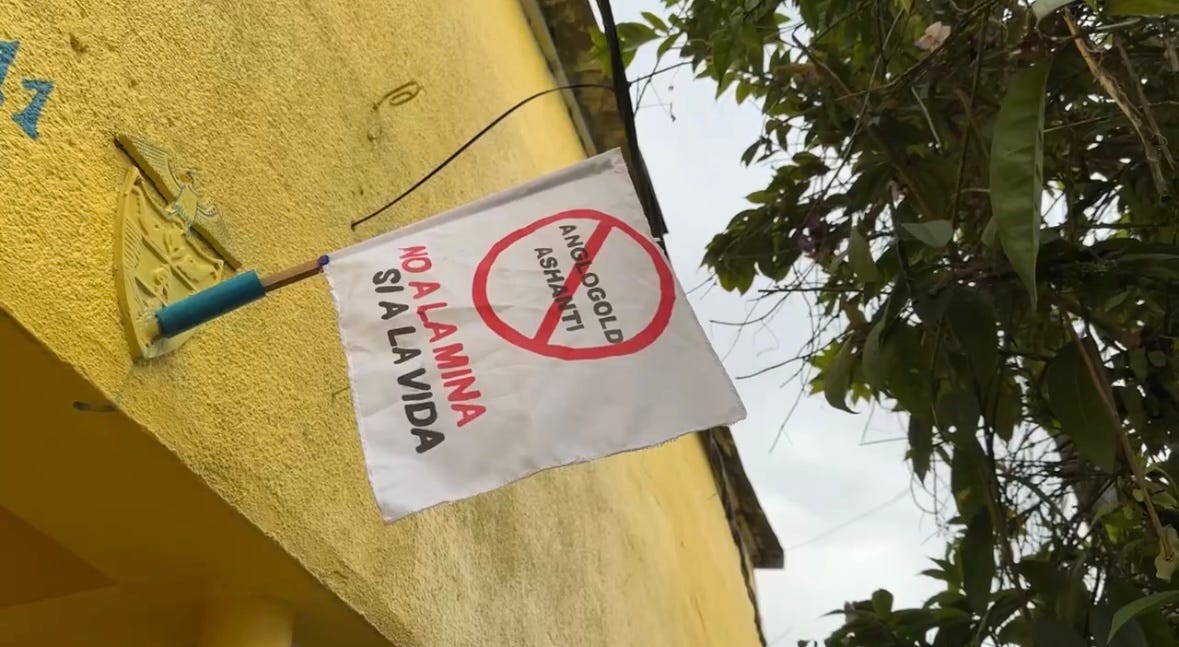Nestled in the foothills of the Andes in Antioquia, Colombia, lies a network of resistance. Passing through, you may be hard pressed to notice. But the clues are everywhere if you know what to look for: Flags hang over doorways, boldly stating: “NO A LA MINA.” Posters are hung in shop windows with the same message. Beautiful art adorns the streets, bringing to life the spirits of the mountains, of water, of life itself, the message of togetherness and interdependence spelled out in the poetry alongside them. Patterned bracelets, bright in defiance, flash on the wrists of villagers who greet each other, laughing. A stranger could miss all the little clues and remain completely unaware of what the people of this small town have achieved. The guardians of these mountains are keeping at bay the second-largest gold mining company in the world from tearing up their home.
We arrived on January 1st to uproarious celebrations welcoming the New Year. The entire town was out, drinking and dancing and laughing. We wandered past statues dedicated to the town’s founding couple and saw groups of men happily snoring at their tables, flanked by beer bottles. Children chased pigeons and fruit sellers chatted merrily together underneath awnings of some of the largest, most colourful fruit we’ve ever seen. Behind the town church, the mountains rose steeply, majestic and lush in their richness. Forest covered the mountain side, a kaleidoscope of dark greens which would shift with the changing light. The land is so rich and wild that Tamesis and the mountain it nestles into are home to five different ecosystems in a range of just a few thousand metres, each winding into the other, like the threads of rope twisting together with purpose and strength. The resistance movement that webs across the mountain side mirrors those very ecosystems, made in the image of the mountain they are dedicated to protecting, interweaving a complex and thoughtful strategy rooted so deeply in the soil that even in the face of danger these unassuming people refuse to budge. They call it Visión Suroeste.
Robert: The resistance recalled images of my Father’s native Samoa. There people escape the tropical heat of the beaming sun under the wall-less thatched roofs of a fale, weaving baskets and fine mats from the long leaves of coconut trees. Each leaf joins an intricate system of patterns, no more, no less important than the last or the next. Visión Suroeste, much like the fine woven mats of Samoa, showcased a beautiful pattern of individuals, groups and initiatives, delicately combined to form not only a formidable network of resistance, but a powerful collective of custodians, defined not by their stance against, but their love of.
When we set out to make films about what to do for a world in crisis, we expected we would learn how to answer that question by the end of the year. We did not expect to come away with answers immediately, but our two weeks with the people of Visión Suroeste were astounding. They have created a project that impeccably applies theories of change to material reality, creating heartfelt impact for both their neighbours and the mountain itself. The guardians’ strategy acutely targets both the immediate threat of the proposed mine and the wider economic systems that facilitate mass destruction in the name of progress, allowing them to weave baskets of relationships to catch themselves in. This protects them from falling prey to the lies, manipulation and perverse incentives which were expertly wielded by AngloGold Ashanti, the mining company embattled in a long and sustained attack to get access to their land.
At the heart of their strategy, the wellspring from which everything grows, is the concept of “territoria” – territory. It was the very first thing we were taught, wandering out of the town towards the river with two members of the movement. Sebastian is a project leader who identifies as a “neo-peasant”, someone returning to his home village in order to be closer to his territory. Astrid, our guide throughout the two weeks, and one of the most effective and joyous people we have known, returned to have her son 16 years prior. They led us down a winding dirt road, Sebastian translating between Spanish and English, explaining that “territory” is a false translation. Territoria is not about ownership or demarcation, it’s a concept that denotes the aliveness of the land, that speaks to the web of life that makes the land, including the mountain itself and the giant boulders which rise up out of the earth, and all the intangible beauty connected to it, like spirits and ancestors and stories. Territoria reflects the reality of all that is and all that has been, a word that carries in it the very being of a place: living, breathing, deserving.
Rachel: I remember that moment with Astrid and Sebastian. Something moved inside me, like a piece slotting into a puzzle. Territoria made concentric circles of all the living beings, refracting how they overlap to create networks of life. It put the villagers in that network, not above it, and immediately captured how they, too, are dependent on the land. Perhaps the thing I loved most about it was that it was this territoria, right here in Tamesis – not the whole state of Antioquia, or the whole land of Colombia. Being bound by their territoria put limits on how far they could scale – meaning they could reserve their energy for rooting down. I thought of Extinction Rebellion in the UK – the very first protest they did through London, pulling that extraordinary pink boat, put climate change on the map. But would it have been more effective to walk down their own high streets instead?
It is easy to see why the locals want to protect this land: it is alive. Sprawling rivers snake across canyons of lush green, their voices gushing into the crisp, misty air. Floating rivers of clouds glide around us, carrying water between corridors of mountain and valley. Vibrant birds colour the landscape with their bright plumage of lurid reds, yellows and blues. Forest covered mountain ranges reach out to the sky, their sharp peaks dotting the skyline with jagged dips and ascensions of pre-historic rock. Adorning these lateral faces are glittering, cascading waterfalls which pour into the rivers Cauca and Frio whose tributaries reach out with infinite fingers into every part of the ecosystem, a venal system pumping life into the network. Flowers flamboyantly dance in gentle breezes, swaying with the thick foliage, attracting large bees to pollinate their companions. Hummingbirds hover about their nectar with rapid silent wings almost imperceivable to our eyes, and fat plump fruit dangles everywhere from the trees and vines. The richness here is self-evident and intangible.
Robert: At what point did we decide that such ecosystems of pure, innocent beauty could be annihilated and sacrificed in pursuit of the twisting of human society into a homogenous, industrial amalgamation of glass, metal and concrete? Surely no one would argue that this region would be improved by a Starbucks or a casino. Yet there is a willingness to trade regions like this to build ‘developed’ cities thousands of kilometers away. The distance from the scene of the crime perhaps enables our ignorance that wondrous self-maintaining ecosystems are being destroyed to maintain others of overconsumption and frivolity.
Although the town was only founded in 1858, there are eons of history in the soil. Intricate markings etched into boulders show that this mountain was once sacred to the people who lived here before the Spanish arrived. But they had moved on by the time the town was founded, which quickly developed a tradition of agriculture in the rich soils. The farmers have long grown coffee, bananas, avocado, oranges, maracuja, passion fruit and so on. To this day, farmers descend from the mountain side into the town with donkeys to collect supplies for themselves and their neighbours. The town works in that intricate way of living organisms who have developed the processes they need to survive. On one journey to visit Jerico, the next town where the mining company has opened up an office, we saw the bus conductor doubling as a postman, taking packages from people on the side of the road who explained where they needed to go. He would holler for the bus to stop and take the package to the front door, sometimes carrying huge sacks of rice on his shoulders. Three hours from the nearest city, the people of Tamesis have developed the systems they need to live well – and many of those systems are built on faith.
Mining would have a devastating impact on the community. It would pollute the rivers, poison the soil, suck in the youth, create wealth inequality, attract illegal activity and, above all, inhibit their ability to fend for themselves. The mine offers the locals short-term financial gain for long-term poverty, destroying the traditions and histories which give these people their identity and the systems which have organically sprung up between them. And, when the lease was up and the company gone, leaving behind a gaping wound in the mountain, grey rivers and wasted soil, the community would have no territoria to go back to, no local economy to go back to. They would be uprooted in themselves, just like the mountain they defend.
We quickly learned that the mining company was targeting the gold in the bellies of the mountain in the name of the energy transition. This is a tension that land defenders have to face down in resource-rich territories. Like Western activists, these environmentalists also want to see the end of fossil fuels – but they refuse to have it come at the cost of their home. We interviewed farmers, scientists, high school students, agro-ecological innovators, youth leaders, indigenous defenders and even a Catholic nun. Each person a thread adding their own touches of colour and elements of light to this plural network. Their chorus rang clear: Not here.
The defence movement of Visión Suroeste is keenly aware that the wealth dug out of the mountains they protect will not stay with them. It won’t even stay in Colombia, they told us, explaining that the energy transition is yet another manifestation of extractivism and neocolonialism. Why should the global north go green at their expense? And why should they believe that green energy will be inherently positive if it’s sourced with the same violence as fossil fuels?
Rachel: I felt relieved having this conversation over and over again. I’ve long questioned the dominant narrative of simply switching to renewable energy as if that will solve all our problems, and many people disagree with my stance. Renewables are a huge driver of tension in the eco-movement, and for all the talk of “just transitions”, there’s been very little evidence of it in the real world. The reality is industries are unlikely to change what works for them while their incentive is still to protect the bottom line. There’s also an inherent anthropomorphism of justice if it discludes the right for Territoria to have her own voice. Even if all the human beings of a place agree for it to be sold off to industry to be chopped up and drilled into and dug up – would the other species agree? What consent can the voiceless give? I don’t dispute that we need a different energy source, but surely a just world will never involve one group making unilateral decisions which destroy the web of life? When we humans do that to other humans, it is called genocide.
Sadly, attacks on territoria like Tamesis are not isolated. Most mining now targets the materials needed for renewable energy infrastructure, and many of these mines overlap with designated Protected Areas and Remaining Wilderness areas. These locations also contain a greater density of mines than mining activity which targets different kinds of materials. Studies have shown that mining for renewable energy infrastructure will exacerbate threats to the planet’s remaining biodiversity, and that these threats could even surpass those averted by climate change mitigation.
The world’s biosphere is severely depleted by our industrial action, and many remaining ecosystems are threatened by green industry. The people of Visión Suroeste are doing what they can to protect their territory but we are all interdependent beings in the great web of life that is planet earth. We are all home to one territoria, even if we cannot defend it all at once. To do so, we need to come together and take responsibility for where we are, and grow our roots deep in the soil to reach out to one another and stimulate the life that once teemed beneath the surface. If we don’t, we will never keep at bay the corporate multinationals which fail to see value in the intangible. And once they get their claws in, there is no end to the destruction they are willing to wreak to get their hands on what they want – as we saw firsthand.
PART 2: The Mine, coming this week.












Beautiful and true. Fierce Love invites honest, vulnerable engagement as it also shields against indifference. Grateful to you as you make yourselves vulnerable on this journey of empathetic inquiry.
Wow. Glad I subscribed! This story needs to be heard. We need words to inspire us, help us know that action can still be so much more than a potentially futile gesture in the face of ‘unstoppable’ juggernaut forces. I salute you both.